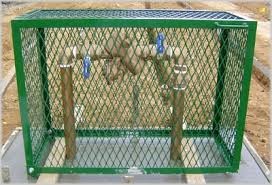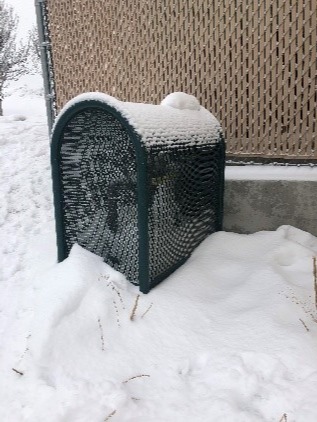Making the right decision when it comes to backflow enclosures, as with any investment or major purchase, requires comprehensive consideration and research. Whether it’s a new vehicle, a new home or even rehabilitation from a major medical procedure, knowing how much effort needs to go into maintaining any of these should be a serious decision point. The same can be said for choosing a backflow enclosure: can I get away with a backflow preventer cage? Or should I choose aluminum?
We’ll grant that, in a vacuum, the questions above aren’t fairly worded. Weigh out the potential maintenance challenges with backflow preventer cages, though, you’ll see that there really isn’t a decision to be made: if you try to make a cage work, you’ll invite a host of headaches when it comes to upkeep.
Watch Your Head: Backflow Cages and Space Constraints
 Backflow cages have fixed dimensions, so, while they literally enclose a backflow preventer or backflow assemblies, they present two indirectly related problems: first, if they are properly sized for the enclosure, they cannot provide both adequate space for servicing the backflow – a requirement in many states’ building codes. If the backflow preventer cage neatly surrounds the backflow and is properly secured to a concrete slab, it necessarily restricts a person’s ability to service it.
Backflow cages have fixed dimensions, so, while they literally enclose a backflow preventer or backflow assemblies, they present two indirectly related problems: first, if they are properly sized for the enclosure, they cannot provide both adequate space for servicing the backflow – a requirement in many states’ building codes. If the backflow preventer cage neatly surrounds the backflow and is properly secured to a concrete slab, it necessarily restricts a person’s ability to service it.
Additionally, if the backflow preventer cage is oversized to accommodate maintenance, it’s also oversized for thieves to find ways to break into it. One should also consider that, like many a pro wrestling match, if a steel cage is made to be accessible, it’s made to be broken into.
Backflow Preventers Still Need Insulation
 We’ve mentioned time and again the fact that backflow preventer cages provide no protection from extreme heat or cold. With extreme weather leaving no part of the country unaffected, those who choose a cage still need to provide secondary solutions to protect their waterworks equipment, especially in the winter.
We’ve mentioned time and again the fact that backflow preventer cages provide no protection from extreme heat or cold. With extreme weather leaving no part of the country unaffected, those who choose a cage still need to provide secondary solutions to protect their waterworks equipment, especially in the winter.
That means unsightly bags, either insulated and secured (ostensibly redundant inside a cage) or of the off-the-shelf variety found in any grocery store. Or it means rolling the dice and hoping the weather doesn’t get wild.
A Backflow Preventer Still Needs Secondary Security
As mentioned above, a cage’s inherent limitations require secondary actions to protect against extreme weather. We’ve talked recently about instances where theft from cages have resulted in unexpected lost revenue and municipal damage, saying nothing of wasted manpower and a critical natural resource. Run a Google search for backflow preventer cage theft, and you’ll find images of backflow cages with cage enclosure lock downs: one example is fabricated steel tubing with an inner pipe, installed around the cage.
It doesn’t take much to recognize this kind of ancillary product shouldn’t be needed in the first place. This isn’t a failsafe like multi-factor authentication, it’s overkill and overcompensation – a tacit confession that the first countermeasure fundamentally is not good enough.
Taking a Long View Regarding Deterioration
A treated cage, meaning powder coated steel or any other kind of application to the steel structure, is expected to last anywhere from 15-20 years. That sounds great, until you consider that a marine grade aluminum backflow preventer enclosure braced with California redwood can reasonably be expected to last for 30 years, and at roughly the same upfront cost.
When It Comes Down to It, There’s No Choice
Cages may be a value similar to that of an insulated bag, but it’s face value: cages don’t represent the best value for protecting your backflow preventer. A Safe-T-Cover modular enclosure provides superior security, protection from the elements, space to service, the right to repair and can outlast any backflow cage on the market.
Don’t box yourself in with insufficient backflow enclosure solutions, make the right call with Safe-T-Cover.




